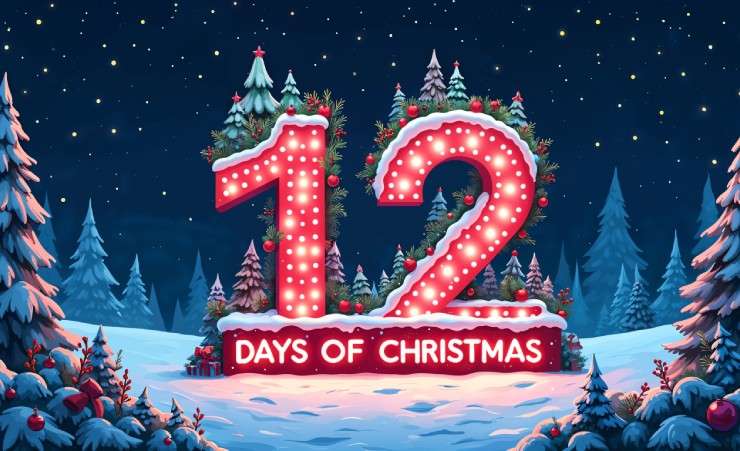Ever thought about what you’d do with seven swans a-swimming or ten lords a-leaping? The “12 Days of Christmas” is one of the season’s quirkiest traditions, packed with twelve days of peculiar presents that spark curiosity year after year. These oddball Christmas gifts have enchanted us for centuries, adding a dash of mystery to the holiday season. But what’s the real story behind each gift, and why have these strange symbols become part of our Christmas lore? Let’s pour a festive drink and look at each curious gift from partridges to drummers!
Timeline: The History of “The 12 Days of Christmas”
The song is first recorded in Mirth Without Mischief, a children’s book. It’s a fun, cumulative rhyme used as an educational tool and Christmas memory game. It was then sung during Twelfth Night celebrations, where guests would recite each verse or pay a forfeit if they slipped up (just imagine the laughs!).
Different versions of the song pop up across the British Isles and beyond. Some verses feature unusual gifts like “bears a-baiting”, “ships a-sailing”, and “colly birds” (an old term for blackbirds). The Scottish version, “The Yule Days”, follows a similar pattern, with a twist on the list of gifts to fit local culture.
English composer Frederic Austin arranges the version we sing today, adding that iconic stretched-out “five go-old rings” (we know you sang that in your head). Austin also smooths out some of the lyrics and finalises the melody, setting the stage for the song’s transformation into a Christmas carol favourite.
PNC Bank begins calculating the cost of all 12 gifts, adding a modern twist to the song. This annual “Christmas Price Index” is a fun (if pricey!) measure of inflation based on “true love’s” shopping spree.
Now, “The 12 Days of Christmas” is as much a part of the holidays as Christmas trees and mince pies. From pop-culture parodies to traditional choirs, it’s sung in various styles, each one celebrating its quirky charm and the imaginative spirit of Christmas.
🎁 Symbolism of the 12 Days of Christmas Gifts
Fun Facts and Trivia
- Did You Know? Frederic Austin, an English composer, added the famous “Five Go-old Rings” melody and finalised the lyrics we sing today!
- Colly Birds: In earlier versions of the song, “calling birds” were “colly birds,” which means blackbirds in Old English.
- PNC Christmas Price Index: Each year, PNC Bank calculates the cost of all these gifts, giving us the current total if we were to “gift” them all. Spoiler: it’s not cheap!
- Fun Financial Fact: If you tried to buy each gift in “The 12 Days of Christmas” just once, it would set you back a whopping USD $45,523.27 (around 67,793 AUD) based on 2022 prices. But if you’re feeling extra generous and plan to get every gift as many times as it’s repeated in the song (all 364 gifts!), you’d need a jaw-dropping USD $197,071.09 (around 297,807 AUD). Those five gold rings aren’t cheap, and neither are nine ladies dancing or seven swans a-swimming! Talk about a luxury Christmas list! 🎁💸
Theories Behind the Gifts
Here’s a closer look at each theory on what the “Twelve Days of Christmas” gifts might mean!
Christian Symbolism Theory
Each gift represents a Christian teaching:
- Partridge in a Pear Tree: Represents Jesus, protecting his “flock” like a mother partridge.
- Two Turtle Doves: The Old and New Testaments.
- Five Gold Rings: The first five books of the Old Testament, known as the Pentateuch.
This modern theory lacks historical documentation, but it’s a fun way to add spiritual significance to the gifts.
French Origins Theory
Some historians believe “The Twelve Days of Christmas” has French origins:
- Gifts like “three French hens” and the cumulative song structure hint at a link to French melodies.
- Similar cumulative verses show up in French folk songs, suggesting cross-cultural influence.
Twelfth Night Celebrations
The song was also part of “memory and forfeits” games during Twelfth Night celebrations in England:
- The game involved singing each verse correctly in sequence or facing a playful forfeit (perhaps buying the next round or sharing a funny story).
- This tradition made the song a fun Christmas game, especially for families and friends.
Global and Cultural Celebrations of the 12 Days
The Twelve Days of Christmas aren’t just a melody—they’re celebrated worldwide in unique and fascinating ways! Here’s how different cultures observe these days, especially as they lead to Epiphany on January 6th.
🌍 Epiphany (January 6th)
- Epiphany, also known as Three Kings’ Day, marks the end of the 12 Days and celebrates the three wise men’s visit to baby Jesus.
- Customs vary, but many cultures keep Christmas decorations until Epiphany, making it a last hurrah for holiday festivities. In France, people enjoy galette des rois (King Cake), a hidden trinket for a lucky finder!
Unique 12 Days Traditions Around the World
- Austria – The Christkindl tradition encourages family members to perform acts of kindness secretly during the 12 Days, creating an atmosphere of love and charity.
- Ethiopia – Known as Timkat, the Ethiopian 12 Days culminate in a three-day celebration of Jesus’ baptism on January 7th. Timkat features vibrant processions and joyful baptisms, with crowds gathering to bless the water.
- Venezuela—Families attend Midnight Mass (known as “Misa de Gallo”) and celebrate with hallacas, a Christmas dish made from maise, filled with meat, and wrapped in plantain leaves—a delicious tradition with family roots.
- Japan – Although Christmas isn’t a public holiday, Japanese families celebrate with their twist: a meal from KFC! The tradition of enjoying fried chicken on Christmas Eve started in the 1970s and remains a quirky part of Japanese Christmas culture.
- Madagascar—Even in warm weather, Malagasy families add some classic touches, decorating with holly and singing Christmas songs. The holiday season here is filled with festive gatherings and community celebrations.
- Bulgaria – Christmas dinner in Bulgaria includes an odd number of vegetarian dishes, which are thought to bring good fortune. After 12 Days of celebrations, families observe Epiphany with blessings of health and wealth for the new year.
Did you know? Epiphany is celebrated as Twelvetide in parts of the UK, where people leave Christmas decorations up for twelve days following Christmas.
A Unique Math Angle: The total number of gifts in The Twelve Days of Christmas adds up to 364, a neat coincidence that covers almost every day of the year!
The Modern Impact and Adaptations of “The 12 Days of Christmas”
🎬 Parodies and Pop Culture
The Twelve Days of Christmas has inspired parodies and adaptations across movies, TV shows, and music. The song’s iconic structure is perfect for creative spins, from humorous versions in shows like The Office to pop-culture takes by artists across genres. For example, there’s often a hilarious twist on the fifth day of Christmas—everything from pizza deliveries to quirky presents replacing “five golden rings.” These adaptations highlight how the song’s playful format keeps it fresh for each generation.
🗓️ “12 Days” as a Christmas Countdown
The 12-day countdown has become a fun and adaptable format for families, brands, and communities. Here are some examples of festive countdowns inspired by the song’s structure:
- Family Christmas Challenges: Families have adopted this format to create activities for each day leading to the New Year. From baking cookies to decorating, it adds a touch of daily magic.
- Holiday Promotions: Brands love the 12-day countdown format for special sales or giveaways. Each day often features a discount or prize, turning shopping into a fun Christmas countdown.
- Festive Challenges: Some communities and social groups use “12 Days” for acts of kindness, creating a holiday spirit inspired by Austria’s Christkindl tradition, which encourages anonymous good deeds.
- Not Advent! 🎄 – Although sometimes mixed up, the 12 Days of Christmas come after December 25th, while Advent marks the four weeks leading up to Christmas.
- Historical Changes in Lyrics ✍️ – Early versions of the song included unique gifts like “colly birds” (an old term for blackbirds) and even “bears a-baiting,” which have since been changed to more familiar words.
- French Origins Theory Recap – The song may have roots in French traditions, reflected in both the style of gift-giving and the repeated, cumulative structure common in French folk songs.
That’s a Wrap on the Twelve Days!
“The Twelve Days of Christmas” is more than just a festive tune—a vibrant blend of history, mystery, and even a touch of financial fun! From medieval memory games and Twelfth Night festivities to its surprising role in modern economics through the PNC Christmas Price Index, this classic carol holds layers of meaning. As it’s sung worldwide, from Dorset to Madagascar, it inspires unique traditions, cultural twists, and even holiday challenges. So next time Christmas, my true love sends a partridge in a pear tree; remember, you’re part of a tradition that spans centuries—adding a bit of magic to every holiday season. Merry Christmas! 🎄
Related Posts
The original DadShop writer, owner, fun loving and tech guy. Great with computers, gadgets, quick on his feet and lover of novelty gifts. Ben writes for our wonderful blog occasionally just to pass time.






